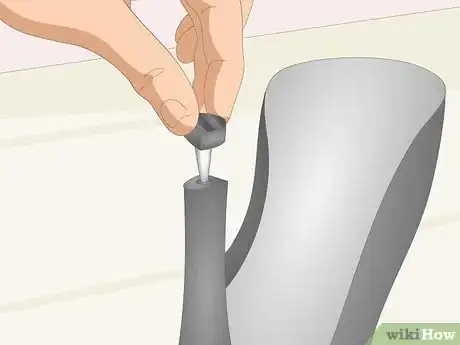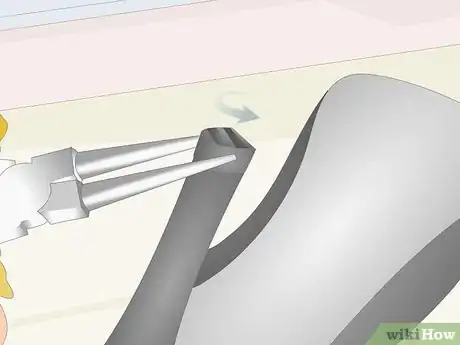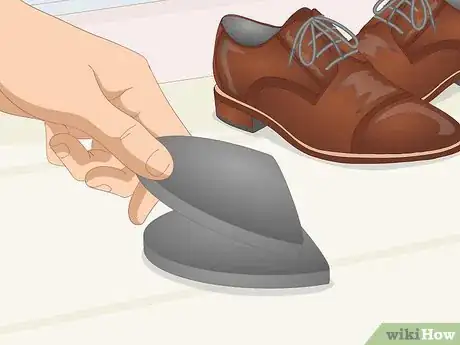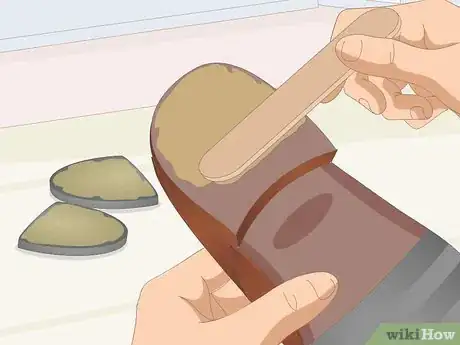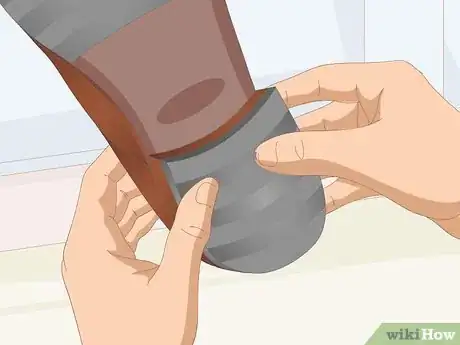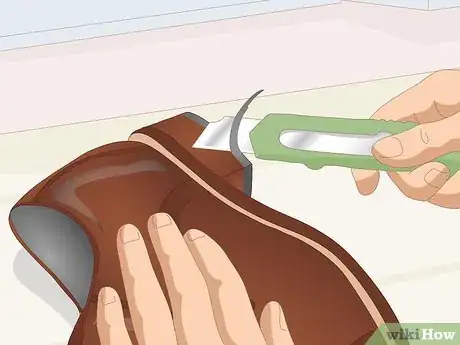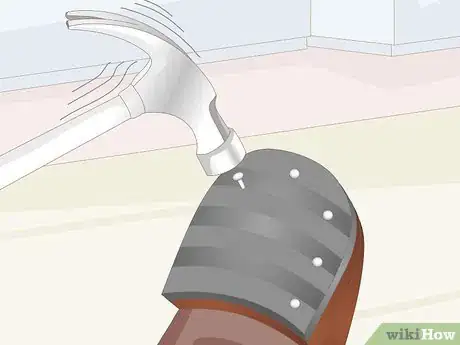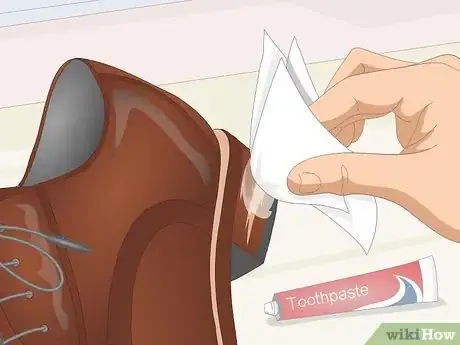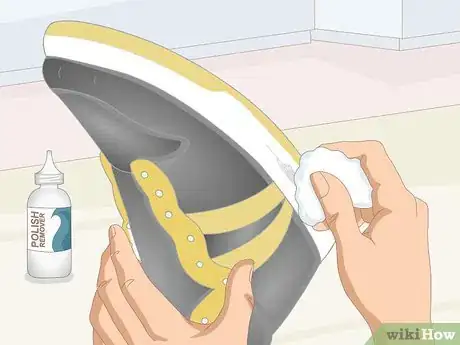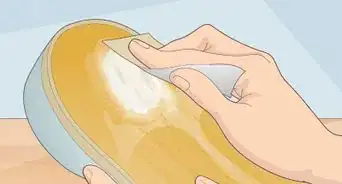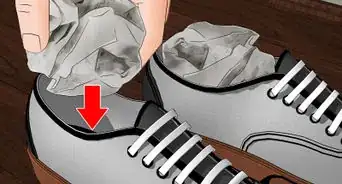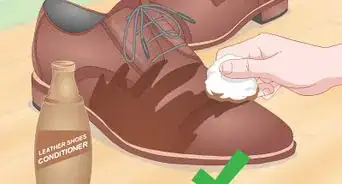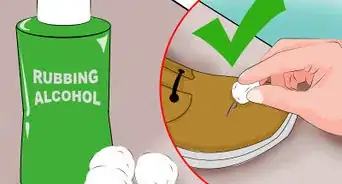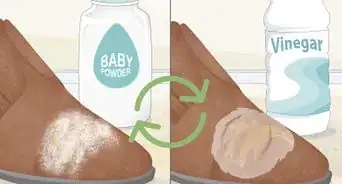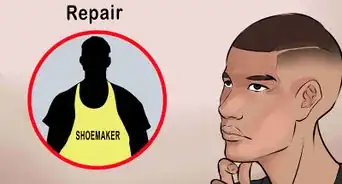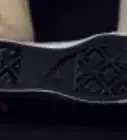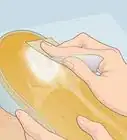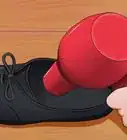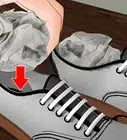This article was co-authored by Trent Potter and by wikiHow staff writer, Hunter Rising. Trent Potter is a Shoe Care and Repair Specialist and the Founder and Co-Owner of Southern Polished and Potter & Sons, a sandal-making business and shoe repair business. With over nine years of experience, he specializes in hand-crafted sandals, shoe cleaning and polishing, and sole and heel repair. Trent holds a BA in Political Science from The University of Tennessee-Knoxville. Trent’s work with Southern Polished has been featured in Nashville Lifestyles, Okra Magazine: Real Southern Culture, Today in Nashville, and Good Grit Magazine. Trent also has a YouTube channel alongside his brother, Heath, called Trenton & Heath, which has over 250K subscribers.
There are 16 references cited in this article, which can be found at the bottom of the page.
This article has been viewed 73,659 times.
Over time, the heels of your shoes will wear down from wearing and walking in them and you may need to replace them. If you have a high heel, then all you need is to put in a new tip before you can walk in them again. If the heel’s worn on a dress shoe, then you need to replace it in order to fix it. Your heels may also get dirty, scuffed, or torn while you wear them, but you can easily clean and make repairs on them.
Steps
Fixing a High Heel Tip
-
1Get a set of replacement heel tips that match your heel. Replacement heel tips are small rubber pieces with metal dowels attached to them so you can put them in your shoe. You can either measure the height and width of your existing heel tip or buy a multipack that has different sizes in it. Make sure the color of the heel tip matches the one on your shoe or else it will clash.[1]
- You can buy replacement heel tips from a shoe store or online.
-
2Pull out the tip of the heel with a pair of needlenose pliers. Grab the rubber end on the bottom of your high heel with a pair of needlenose pliers and slowly pull it straight out. You may have to rotate or shimmy the tip out of place since it will have a tight fit. Once you remove the tip from the shoe, you can throw it away.[2]
- If the rubber on the tip is completely worn away, then grab the metal dowel instead.
- Don’t grab above the rubber tip since you could damage the actual heel of your shoe.
- Try replacing the tips on your high heels before the rubber wears away since it’s easier to remove.
Advertisement -
3Push the new tip into the hole on the heel. Take one of the replacement heel tips and feed the end with the metal dowel into the hole on the bottom of the heel. Try to line up the shape of the tip and heel so it’s easier to make adjustments later on. Push the new tip in as far as you can by hand.[3]
- Set the shoe on a sturdy surface so you can push the tip in further.
- Be careful not to apply too much force to your shoe heel since you could cause it to break off.
-
4Tap the new heel tip into place with a hammer. Hold the shoe sturdy on a stable surface with your nondominant hand. Gently tap the bottom of the heel tip with a hammer to push it into the heel further. Continue tapping the heel tip slowly into the heel until the edges are flush with one another.[4]
- Don’t hit the hammer too hard since you could break the heel or bend the heel tip.
-
5Turn the tip so it lines up with the rest of the heel. Grip the sides of the heel tip with your needlenose pliers and slowly turn the heel tip away. Keep rotating the heel tip in the heel until the curves on the back of the heel line up. Once the heel tip is aligned with the heel, you’re ready to wear your shoes again.[5]
Replacing the Heels on Dress Shoes
-
1Buy a replacement heel for the shoe you’re repairing. You can usually find replacement heels online or at a shoe store. Compare the width, length, and thickness of the replacement heel to the one on your shoes to make sure they are the right fit. Make sure the bottom grip on the heel has the amount of traction you need so you don’t slip later on.[6]
- Replacement heels usually cost around $25 USD for a pair.
- You only need to replace the rubber sole on the heel as long as the larger heel block is still intact.[7]
- If you can’t find a replacement heel that matches the size of your shoe exactly, then get the next largest one so you can trim off the excess.
-
2Pull the heel off of the shoe with a pair of pliers. Grip the rubber on the edge of your heel and slowly pull it backward. Hold the toe of the shoe down with your nondominant hand to get better leverage. Continue pulling the rubber part of the heel up until it comes off completely.[8]
- Many times, you only need to remove the rubber piece on the heel, also known as the top lifts. If the heel platform is damaged, then you also need to remove it the same way.
-
3Use a belt sander to remove excess glue and flatten the bottom of the shoe. Put on safety glasses before using the belt sander so you don’t get any dust in your eyes. Turn on the sander and carefully hold the bottom of the shoe by the heel against the belt. Make sure the shoe bottom is flat against the sander so it smooths out a level surface for the new heel. Check the bottom of the shoe every few seconds to see if it’s flat.[9]
- You can also use 120-grit sandpaper, but it will be more difficult to get the heel perfectly level.
- Don’t touch the belt sander while it’s still running since it will cause serious injury.
-
4Apply contact glue to the shoe bottom and new heel and let it dry for 15 minutes. Contact glue adheres to itself and makes a firm connection between the pieces.[10] Use the glue applicator to spread a thin layer of glue on the back of the replacement heel and the bottom of your shoe. Leave the glue to dry for at least 10-15 minutes so it gets tacky and adheres better.[11]
- You can buy contact glue from your local hardware or craft store.
- Don’t push the heel onto the bottom of the shoe yet since the glue needs to set beforehand.
- Work in a well-ventilated area since contact glue can create fumes that may cause irritation.
-
5Push the heel onto the bottom of the shoe. After the glue dries for 10-15 minutes, line up the heel as best as you can with the bottom of the shoe. When you have the heel lined up, push it down onto the shoe so it makes a firm connection. Apply continuous pressure to the heel for 30-60 seconds so the heel and shoe stay in place. The glue will dry immediately so you can keep working on your shoe.[12]
- The heel will stick to the bottom of the shoe as soon as the contact glue touches, so make sure it’s lined up perfectly before pressing down.
- Try hitting the heel with a hammer to help it stick to the bottom of the shoe better.
-
6Trim the heel around the bottom of the shoe if it doesn’t lie flush. Hold the blade of a utility knife against the side of your shoe next to the new heel. If the heel overhangs the side of the shoe, guide the blade through the rubber around the curves of the heel. Trim as close as you can to the side of your shoe to ensure that the heel doesn’t hang out the side.[13]
- Your knife can easily slip while trimming the heel, so work slowly and carefully so you don’t yourself.
-
7Secure the heel in place with cobbler nails. Cobbler nails are only 1⁄2–7⁄8 in (1.3–2.2 cm) long, but they help hold your heel in place so it doesn’t come off.[14] Place a nail it each of the front corners of the heel and gently tap them into the bottom of the shoe. Then evenly space 3-5 more nails around the back curve of the heel to help secure it in place.[15]
- You can buy cobbler nails at a hardware or shoe store.
- You don’t have to nail down top lifts if you don’t want to, but it can make them more secure.
Cleaning and Repairing the Material
-
1Clean scuffs off of leather with toothpaste. Apply a pea-sized shape of any non-gel toothpaste onto the corner of a cleaning rag. Rub the toothpaste in circular motions on the sides of the heel that have scuffs on them. If you still notice the scuffs after your first application, then use another pea-sized bead of toothpaste and repeat the process again. Continue working until you can’t see the scuff marks anymore.[16]
- You may also use petroleum jelly in place of toothpaste if you want.
- Don’t use gel or colored toothpaste, which can stain light-colored leather.
-
2Wipe rubber heels with nail polish remover to remove marks. Wet the corner of a cleaning rag with nail polish remover, and wring out any excess. Rub the heels of your shoes in a circular motion to help remove any scuff marks from the sides. If the marks don’t come out at first, wet the rag again and continue wiping until they’re clean.[17]
- Avoid using an abrasive rag while you’re cleaning or else you may scratch and damage the rubber.
-
3Rub walnuts on a wooden heel to remove scuffs and scratches. Use unshelled walnuts since they’re easier to break apart and use on your shoes. Hold the walnut against the wood on your heel and apply light pressure while you rub back and forth. The oil from the nuts will help lift and remove any scuff marks and make the shoe appear clean and shiny. Continue rubbing walnuts into the heels until you don’t notice any more marks.[18]
- Do not eat the walnuts you use to clean your shoes.
-
4Use liquid leather to fill in holes on a leather heel. Liquid leather matches the texture and look of real leather so you can hide tears or holes. Use a small applicator, such as a cotton swab or popsicle stick, to scoop out a small bead of liquid leather and spread it over the damaged area on your heel. Press the textured sheet provided with the liquid leather over the area and let it dry for 24 hours. Slowly peel the sheet off the liquid leather once it’s dry so you can wear your shoes again.
- You can buy liquid leather from a shoe or craft store.
- Be sure to use liquid leather that matches the color of your heel so it doesn’t clash with the rest of your shoe.
Community Q&A
-
QuestionCan a shoe repair cut down heels?
 Drew Hawkins1Community AnswerIt depends on the type of shoe. Some shoes can't have their heels altered, but some can without any problems. Take your shoes to a repair shop and see if they can cut your heels down.
Drew Hawkins1Community AnswerIt depends on the type of shoe. Some shoes can't have their heels altered, but some can without any problems. Take your shoes to a repair shop and see if they can cut your heels down. -
QuestionHow do you fix high heels?
 Drew Hawkins1Community AnswerYou can use a pair of replacement heel tips that match your heels. Pull out the tip with a pair of pliers and insert your new heel tip into the hole. Tap it into place with a hammer so it's secure.
Drew Hawkins1Community AnswerYou can use a pair of replacement heel tips that match your heels. Pull out the tip with a pair of pliers and insert your new heel tip into the hole. Tap it into place with a hammer so it's secure. -
QuestionHow do you fix shoe soles at home?
 Drew Hawkins1Community AnswerIf you have a replacement heel, you can pull off the old heel with a pair of pliers. Then, sand off the excess glue and apply new contact glue to the bottom. Push the replacement heel into place and secure it by installing small cobbler nails in the corners.
Drew Hawkins1Community AnswerIf you have a replacement heel, you can pull off the old heel with a pair of pliers. Then, sand off the excess glue and apply new contact glue to the bottom. Push the replacement heel into place and secure it by installing small cobbler nails in the corners.
Warnings
- Never touch the belt on a belt sander while it’s moving since it can cause serious injury.⧼thumbs_response⧽
- Always wear safety glasses when using a belt sander.⧼thumbs_response⧽
Things You’ll Need
Fixing a High Heel Tip
- Replacement high heel tips
- Needlenose pliers
- Hammer
Replacing the Heels on Dress Shoes
- Replacement heel
- Pliers
- Belt sander
- Contact glue
- Utility knife
- Cobbler nails
- Hammer
Cleaning and Repairing the Heel
- Walnuts
- Toothpaste
- Cleaning rag
- Nail polish remover
- Liquid leather
References
- ↑ https://youtu.be/IVg0VlhbdjE?t=206
- ↑ https://youtu.be/IVg0VlhbdjE?t=130
- ↑ https://youtu.be/zOIklQgJUbE?t=101
- ↑ https://youtu.be/zOIklQgJUbE?t=115
- ↑ https://youtu.be/IVg0VlhbdjE?t=318
- ↑ https://youtu.be/ODsApyQ5BNo?t=101
- ↑ Trent Potter. Shoe Care & Repair Specialist. Expert Interview. 22 April 2021.
- ↑ https://youtu.be/6jSg4wMtOu0?t=126
- ↑ https://youtu.be/6jSg4wMtOu0?t=180
- ↑ Trent Potter. Shoe Care & Repair Specialist. Expert Interview. 22 April 2021.
- ↑ https://youtu.be/ODsApyQ5BNo?t=883
- ↑ https://youtu.be/ODsApyQ5BNo?t=1093
- ↑ https://youtu.be/ODsApyQ5BNo?t=1555
- ↑ Trent Potter. Shoe Care & Repair Specialist. Expert Interview. 22 April 2021.
- ↑ https://youtu.be/_VYMNcEdQj0?t=57
- ↑ https://www.hermoney.com/enjoy/fashion/quick-fixes-fashion-emergencies/
- ↑ https://youtu.be/yiM-QxIOZAY?t=75
- ↑ https://youtu.be/3C9On4Tnlvk?t=32


